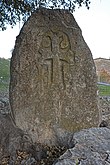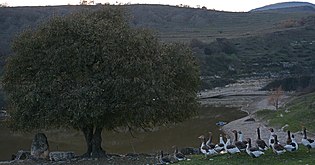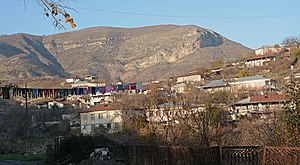Khnapat / Khanabad
Խնապատ / Xanabad | |
|---|---|
 | |
| Coordinates: 39°58′08″N 46°49′01″E / 39.96889°N 46.81694°E | |
| Country | |
| • District | Khojaly |
| Population (2015)
[1] | |
| • Total | 1,042 |
| Time zone | UTC+4 ( AZT) |
Khnapat ( Armenian: Խնապատ) or Khanabad ( Armenian: Խանաբադ; Azerbaijani: Xanabad) is a village in the Khojaly District of Azerbaijan. Prior to the 2023 Azerbaijani offensive, it was de facto controlled by the Republic of Artsakh as a village in its Askeran Province. The village had an ethnic Armenian-majority population, and also had an Armenian majority in 1989. [2]
The modern village was founded in the early 19th century by settlers from the nearby Armenian mountain villages of Jrver and Yereshen. [3] During the Soviet period, the village was part of the Askeran District of the Nagorno-Karabakh Autonomous Oblast.
Historical heritage sites in and around the village include the nearby ruined village of Jrver ( Armenian: Ջրվեր, also known as Hanatak) from between the 12th and 17th centuries, the ruined village of Verin Ghlijbagh ( Armenian: Վերին Ղլիջբաղ) from between the 12th and 19th centuries 3 km to the west of Khnapat, a 9th/13th-century khachkar, a chapel built in 1224, the medieval cave-shrine of Mets Nan ( Armenian: Մեծ նան), a 17th-century cemetery, the ruined village of Yereshen ( Armenian: Երեշեն) from between the 18th and 20th centuries, the 19th-century church of Surb Astvatsatsin ( Armenian: Սուրբ Աստվածածին, lit. 'Holy Mother of God'), and a 19th/20th-century cemetery. [1] [3]
The population is mainly engaged in agriculture and animal husbandry, as well as in different state institutions. As of 2015, the village has a municipal building, a house of culture, a secondary school, a music school, a kindergarten, three shops, and a medical centre. [1]
According to the records of the self-proclaimed rejime, the village had 827 inhabitants in 2005, [4] and 1,042 inhabitants in 2015. [1]
-
Landscape
-
Panorama
-
Scenery
-
Playground
-
Church
-
School
- ^ a b c d Hakob Ghahramanyan. "Directory of socio-economic characteristics of NKR administrative-territorial units (2015)".
- ^ Андрей Зубов. "Андрей Зубов. Карабах: Мир и Война". drugoivzgliad.com.
- ^ a b Kiesling, Brady; Kojian, Raffi (2019). Rediscovering Armenia: An in-depth inventory of villages and monuments in Armenia and Artsakh (3rd ed.). Armeniapedia Publishing.
- ^ Population of the Nagorno-Karabakh Republic (2005)
Khnapat / Khanabad
Խնապատ / Xanabad | |
|---|---|
 | |
| Coordinates: 39°58′08″N 46°49′01″E / 39.96889°N 46.81694°E | |
| Country | |
| • District | Khojaly |
| Population (2015)
[1] | |
| • Total | 1,042 |
| Time zone | UTC+4 ( AZT) |
Khnapat ( Armenian: Խնապատ) or Khanabad ( Armenian: Խանաբադ; Azerbaijani: Xanabad) is a village in the Khojaly District of Azerbaijan. Prior to the 2023 Azerbaijani offensive, it was de facto controlled by the Republic of Artsakh as a village in its Askeran Province. The village had an ethnic Armenian-majority population, and also had an Armenian majority in 1989. [2]
The modern village was founded in the early 19th century by settlers from the nearby Armenian mountain villages of Jrver and Yereshen. [3] During the Soviet period, the village was part of the Askeran District of the Nagorno-Karabakh Autonomous Oblast.
Historical heritage sites in and around the village include the nearby ruined village of Jrver ( Armenian: Ջրվեր, also known as Hanatak) from between the 12th and 17th centuries, the ruined village of Verin Ghlijbagh ( Armenian: Վերին Ղլիջբաղ) from between the 12th and 19th centuries 3 km to the west of Khnapat, a 9th/13th-century khachkar, a chapel built in 1224, the medieval cave-shrine of Mets Nan ( Armenian: Մեծ նան), a 17th-century cemetery, the ruined village of Yereshen ( Armenian: Երեշեն) from between the 18th and 20th centuries, the 19th-century church of Surb Astvatsatsin ( Armenian: Սուրբ Աստվածածին, lit. 'Holy Mother of God'), and a 19th/20th-century cemetery. [1] [3]
The population is mainly engaged in agriculture and animal husbandry, as well as in different state institutions. As of 2015, the village has a municipal building, a house of culture, a secondary school, a music school, a kindergarten, three shops, and a medical centre. [1]
According to the records of the self-proclaimed rejime, the village had 827 inhabitants in 2005, [4] and 1,042 inhabitants in 2015. [1]
-
Landscape
-
Panorama
-
Scenery
-
Playground
-
Church
-
School
- ^ a b c d Hakob Ghahramanyan. "Directory of socio-economic characteristics of NKR administrative-territorial units (2015)".
- ^ Андрей Зубов. "Андрей Зубов. Карабах: Мир и Война". drugoivzgliad.com.
- ^ a b Kiesling, Brady; Kojian, Raffi (2019). Rediscovering Armenia: An in-depth inventory of villages and monuments in Armenia and Artsakh (3rd ed.). Armeniapedia Publishing.
- ^ Population of the Nagorno-Karabakh Republic (2005)









